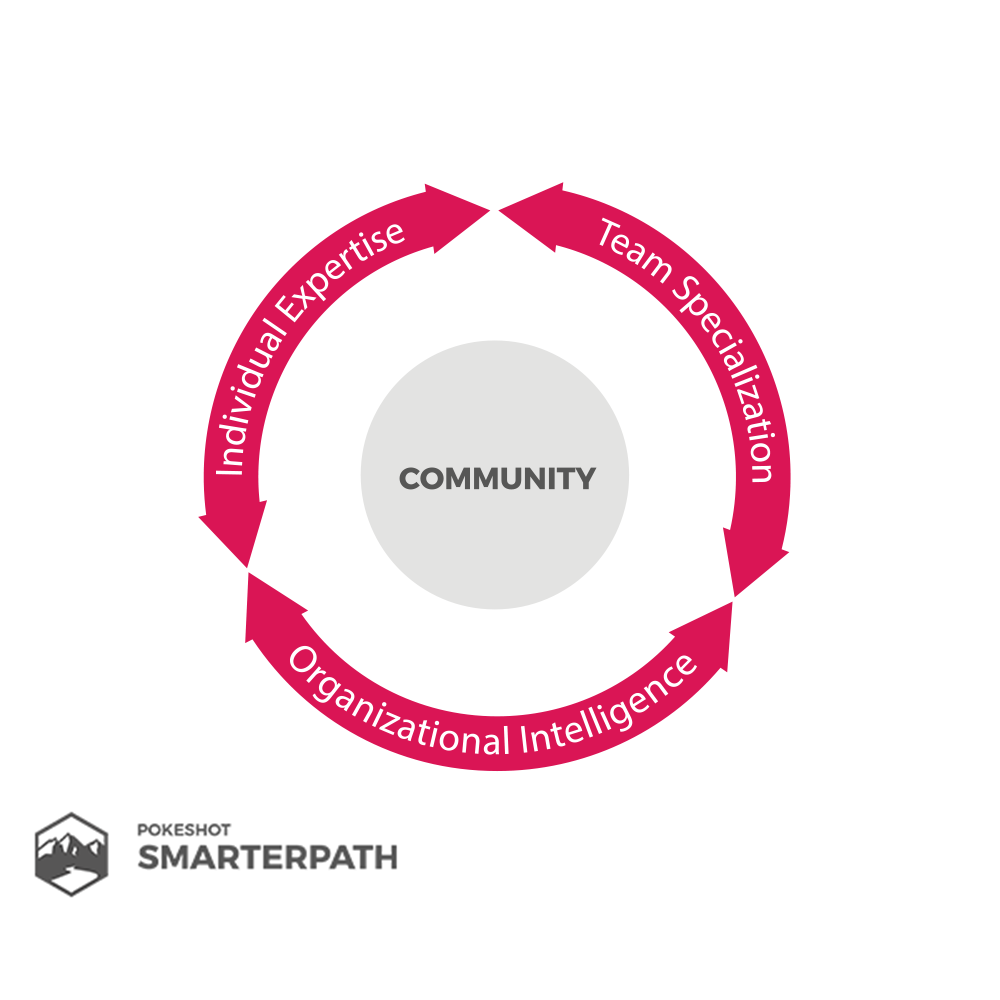On my bookshelf for the last several years, Etienne Wenger’s Cultivating Communities of Practice: A Guide to Managing Knowledge is quite a read! Written in 2002, it is as timely and relevant as if it was written yesterday. For some, the concept of “community” may be seen as more of a social structure than a business tool. However, there is no doubt that in the organizations Wenger profiles, deliberate and purposeful social networks – such as those represented by online learning communities – are essential to a wide variety of impactful outcomes.
As defined by Wenger, communities of practice are:
“groups of people who share a concern, a set of problems, or a passion about a topic, and who deepen their knowledge and expertise in this area by interacting on an ongoing basis.”
He goes on to explain:
“These people don’t necessarily work together every day, but they meet because they find value in their interactions. As they spend time together, they typically share information, insight, and advice. They help each other solve problems. They discuss their situations, their aspirations, and their needs. They ponder common issues, explore ideas, and act as sounding boards. They may create tools, standards, generic designs, manuals, and other documents—or they may simply develop a tacit understanding that they share. However they accumulate knowledge, they become informally bound by the value that they find in learning together.”
In other words, with the right support, what starts out as organic and personal levels of engagement can evolve into a collective network – a community – that has practical and meaningful business impacts.
It seems to me then that there’s a self-fulfilling cycle at work here. A company’s organizational intelligence is based on it’s ability to at least tap into, if not codify or productize, the collective knowledge of its employees. The collective know-how of a team of co-workers only exists because of the insights and specialized knowledge each employee has. At the same time, each individual’s insights and evolving knowledge are maintained by his or her interactions within the community. And it’s the community – the network – that surfaces/manifests the collective knowledge of the organization.

In what is just an early-stage example of this cycle in action, one of my former employers piloted a community of practice approach as part of a leadership development program. Using a nomination/selection process, supervisors and managers from different departments became part of the so-called “Community of Thinkers.” Designed to build critical thinking and analysis skills in operational leaders, the months-long blended learning program was structured around developing solutions to several of the organization’s strategic challenges. The ability for these front-line leaders – many of whom were long-time employees – to apply their different perspectives to a specific set of challenges was in-part designed to provide senior leadership with insights that they would not likely have had access to otherwise. Armed with these insights, the intended result was better executive decision-making regarding the future of the organization.
As a learning professional who was involved with this project, what I still find compelling about it is the opportunity for a leadership development program – a program whose primary purpose was skill-building for managers – to also have an impact on the operations of the business. And this impact had the potential to not only be seen when an individual manager worked to apply the lessons learned in his or her department, but also when the C-suite made decisions about where to invest resources going forward. There was certainly opportunity for this approach to have evolved much further within the organization, but even within the context of a staff development program, it is a good example of how community can have strategic/business value.
While Wenger’s research of course adopts a wider perspective than strictly learning-based use cases, there’s no doubt that learning can be the catalyst for applying communities of practice to a variety of situations. Here, then, are a few more points from his book:
- “The point, after all, is not to launch communities for their own sake, but to build the organization’s overall capacity to learn and innovate.”
– Online learning experiences and knowledge bases can be created at the same time. - “Communities are most effective when they connect teams across divisions to catalyze ideas and solutions that would not be discovered otherwise.”
– Because community connections are based on relationships and shared interests/experiences, the org chart does not represent the only way work gets done. - “If knowledge becomes the central driver of an organization’s business, we should expect communities to play an increasingly central role.”
– In most organizations – where intellectual property is the business – communities of practice are simply essential.
Where are you currently using communities of practice in your organization? What challenges would you like to tackle using communities of practice?
In an upcoming blog post I’ll explore a related concept from Wenger’s – and others’ – work: developing a knowledge strategy for your organization.
 Stan’s first experience with instructional technology occurred in 1999 when he used SMART Boards to help employees learn how to use the Microsoft Office Suite. He then became an instructional designer and systems trainer for a variety of proprietary CRM software solutions. From there, Stan worked as a Training Manager and later as a Project Manager for an early leader in online education. As his experience with online learning grew, and as his understanding of the need to connect strategy with technology evolved, Stan began to focus on the relationship between blended learning and social business. It was these insights that attracted him to Jive and Pokeshot’s SmarterPath LMS the first time he saw it in 2012. Stan’s current role with the company not only allows him to support the sales, marketing, and product development teams, but it also allows him to work directly with customers as they implement SmarterPath. Prior to joining Pokeshot in October 2016, Stan spent several years working as a freelance consultant, successfully completing learning technology projects for such clients as Right Management, National University System and the U.S. Forest Service.
Stan’s first experience with instructional technology occurred in 1999 when he used SMART Boards to help employees learn how to use the Microsoft Office Suite. He then became an instructional designer and systems trainer for a variety of proprietary CRM software solutions. From there, Stan worked as a Training Manager and later as a Project Manager for an early leader in online education. As his experience with online learning grew, and as his understanding of the need to connect strategy with technology evolved, Stan began to focus on the relationship between blended learning and social business. It was these insights that attracted him to Jive and Pokeshot’s SmarterPath LMS the first time he saw it in 2012. Stan’s current role with the company not only allows him to support the sales, marketing, and product development teams, but it also allows him to work directly with customers as they implement SmarterPath. Prior to joining Pokeshot in October 2016, Stan spent several years working as a freelance consultant, successfully completing learning technology projects for such clients as Right Management, National University System and the U.S. Forest Service.
2 thoughts on “Community with a Capital C”
Comments are closed.